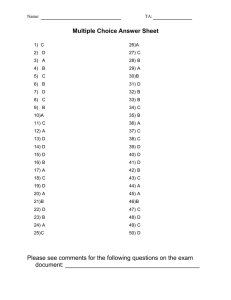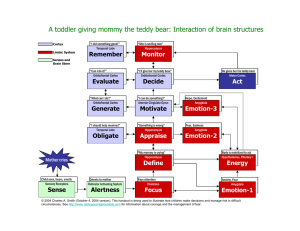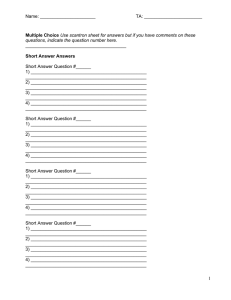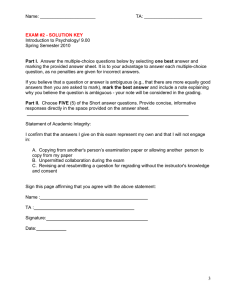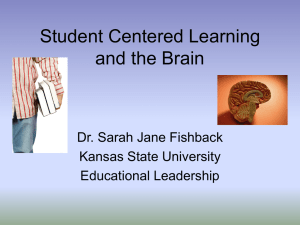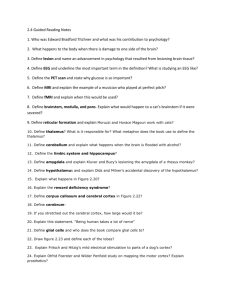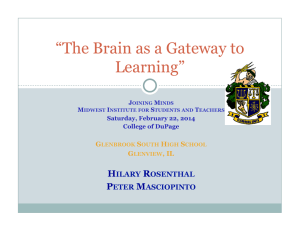Multiple Choice Answer Sheet
advertisement
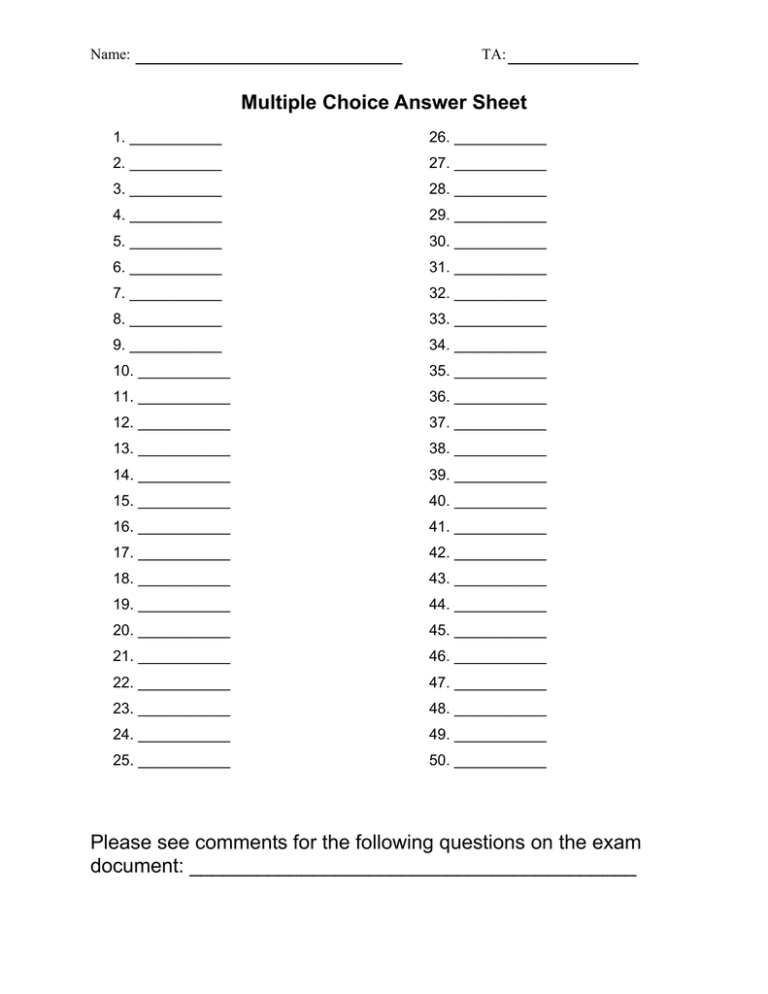
Name: TA: Multiple Choice Answer Sheet 1. ___________ 26. ___________ 2. ___________ 27. ___________ 3. ___________ 28. ___________ 4. ___________ 29. ___________ 5. ___________ 30. ___________ 6. ___________ 31. ___________ 7. ___________ 32. ___________ 8. ___________ 33. ___________ 9. ___________ 34. ___________ 10. ___________ 35. ___________ 11. ___________ 36. ___________ 12. ___________ 37. ___________ 13. ___________ 38. ___________ 14. ___________ 39. ___________ 15. ___________ 40. ___________ 16. ___________ 41. ___________ 17. ___________ 42. ___________ 18. ___________ 43. ___________ 19. ___________ 44. ___________ 20. ___________ 45. ___________ 21. ___________ 46. ___________ 22. ___________ 47. ___________ 23. ___________ 48. ___________ 24. ___________ 49. ___________ 25. ___________ 50. ___________ Please see comments for the following questions on the exam document: ________________________________________ Short Answer Answer Sheet Short Answer Question #______ 1) ______________________________________________ 2) ______________________________________________ 3) ______________________________________________ 4) ______________________________________________ Short Answer Question #______ 1) ______________________________________________ 2) ______________________________________________ 3) ______________________________________________ 4) ______________________________________________ Short Answer Question #______ 1) ______________________________________________ 2) ______________________________________________ 3) ______________________________________________ 4) ______________________________________________ Short Answer Question #______ 1) ______________________________________________ 2) ______________________________________________ 3) ______________________________________________ 4) ______________________________________________ Short Answer Question #______ 1) ______________________________________________ 2) ______________________________________________ 3) ______________________________________________ 4) ______________________________________________ EXAM #2 Introduction to Psychology/ 9.00 Spring Semester 2009 Part I. Answer the multiple-choice questions below by selecting one best answer and marking the provided answer sheet. It is to your advantage to answer each multiplechoice question, as no penalties are given for incorrect answers. If you believe that a question or answer is ambiguous (e.g., that there are more equally good answers then you are asked to mark), mark the best answer and include a note explaining why you believe the question is ambiguous - your note will be considered in the grading. Part II. Choose FIVE (5) of the Short answer questions. Provide concise, informative responses directly in the space provided on the answer sheet. Statement of Academic Integrity: I confirm that the answers I give on this exam represent my own and that I will not engage in: • • • Copying from another's person’s examination paper or allowing another person to copy from my paper Unpermitted collaboration during the exam Revising and resubmitting a question for regrading without the instructor's knowledge and consent Sign this page affirming that you agree with the above statement: Signature: Date: Lecture and Sacks Questions 1) Difficult and controversial court cases occur if an accusation is based on alleged memories for remote events when that memory has been repressed for many years and recovered during therapy. What memory phenomenon is most threatening to the accuracy of these sorts of memories? a. b. c. d. Encoding specificity Proactive interference Retroactive interference Flashbulb memories 2) In an experiment aimed to study short-term memory, subjects were asked to remember three-letter consonant trigrams (LCK) during retention intervals, during which they counted aloud, ranging from 0 to 18 seconds. On average, recall for the trigrams was virtually absent after 18 seconds. Subsequent studies revealed that the poor memory at 18 seconds was primarily due to a. b. c. d. Limited capacity of short-term memory Serial position effect Retroactive interference in long-term memory Proactive interference in long-term memory 3) Declarative memory depends on the _______; procedural memory depends on the _____; repetition priming depends on ______. a. b. c. d. Hippocampus; basal ganglia; neocortex Basal ganglia; hippocampus; neocortex Basal ganglia; neocortex; hippocampus Hippocampus; neocortex; basal ganglia 4) A patient with a left-sided removal of the hippocampus would be impaired on which of the following: a. a. b. c. Short-term verbal memory Long-term verbal memory Short-term visuo-spatial memory Long-term visuo-spatial memory 5) Patients with anterograde global amnesia typically have a. No retrograde amnesia at all b. Retrograde amnesia for the most distant past parts of their lives c. Temporally limited retrograde amnesia d. Complete retrograde amnesia 6) The field has once considered babies before age 12 months as pre-linguistic. Current evidence suggests: a. Even though they don’t speak yet, infants can fully understand language before 12 months. b. Key universal linguistic milestones occur before 12 months. c. Most infants can talk before 12 months. d. Babies are indeed pre-linguistic before 12 months. 7) We know that babbling in infants is related to language acquisition because: a. Right side of the mouth (controlled by left hemisphere) opens first during babbling b. Deaf children babble with their hands, showing that babbling is not just a practice of vocal cords. c. Bilingual babies exposed to Signed and Spoken languages babble with their hands and their mouth. d. All of the above. 8) Experimental studies show that, for equal losses or gains, people are a. b. c. d. Risk averse for losses and gains Risk taking for losses and gains Risk averse for gains and risk taking for losses Risk taking for gains and risk averse for losses 9) People often think that (a) 8 x 7 x 6 x 5 x 4 x 3 x 2 x 1 is a much larger number than 1 x 2 x 3 x 4 x 5 x 6 x 7 x 8; (b) it is more likely to have a coin flipped six times come up with a mix of heads and tails than all heads; and (c) that a person is at greater risk in the US to die from a terrorist attack than a bathtub accident. These ways of thinking reflect, in order, what heuristics? a. b. c. d. (a) representativeness; (b) anchoring; (c) availability (a) availability; (b) representativeness; (c) anchoring (a) representativeness; (b) availability; (c) anchoring (a) anchoring; (b) representativeness; (c) availability 10) Perseveration in problem solving is found after injuries to the _______; failure to exhibit a galvanic skin response (GSR) to family members is found after injuries to the _____; a heightened tendency to make selections that have high immediate rewards but higher long-term losses is found after injuries to the a. dorsolateral prefrontal cortex; orbitofrontal cortex; orbitofrontal cortex b. orbitofrontal cortex; orbitofrontal cortex; dorsolateral prefrontal cortex c. dorsolateral prefrontal cortex; dorsolateral prefrontal cortex; orbitofrontal cortex d. dorsolateral prefrontal cortex; orbitofrontal cortex; dorsolateral prefrontal cortex 11) Experimental evidence indicates that memorizing material with repeated study and test cycles, like learning foreign language vocabulary, is done both best and most efficiently if students a. study all materials repeatedly and are tested on all materials repeatedly b. study all materials repeatedly and are tested only on materials that were missed in the prior test c. only study materials missed on the prior test and are tested on all materials repeatedly d. only study materials missed on the prior test and are tested only on materials missed in the prior test 12) Which is NOT true about IQ scores according to available evidence? a. b. c. d. IQ scores are holding steady around the world crystallized intelligence shows little decline in normal aging IQ scores, according to twin studies, are about 50% heritable birth-order has an effect on IQ scores 13) Which of the following could be interpreted as support for the James-Lange hypothesis that a bodily response leads to a subjective experience of emotion? a. using pencils to force a smile or prevent a smile alters emotional experience b. following instructions to move facial musculature into specific expressions enhances emotional experience consistent with that expression c. men were more likely to call a woman they met in the middle of a dangerous bridge than a safe bridge d. all of the above 14) Imaging studies of the amygdala indicate that all of the below EXCEPT a. b. c. d. selective response to fearful faces in subliminal presentations selective response to fearful faces in a cortically blind visual field greater amygdala responses to scenes judged as more negatively intense greater amygdala activation on the left for emotionally intense scenes that are later remembered by men 15) Which is NOT true about measures of personality? a. b. c. d. their stability increases with age personality traits, according to twin studies, are about 50% heritable conscientiousness appears to diminish risk of Alzheimer’s disease children are more similar to an adoptive sibling than to a randomly selected child 16) If you are introverted and have to take a test, research indicates that to perform best you should a. consume caffeine if the test is in the morning, but do not consume caffeine if the test is in the afternoon b. consume caffeine if the test is in the afternoon, but do not consume caffeine if the test is in the morning c. consume caffeine for a test either in the morning or in the afternoon d. do not consume caffeine for a test either in the morning or in the afternoon 17) Which Big Five personality factor tends to increase with age? a. b. c. d. conscientiousness neuroticism openness agreeableness 18) Which is NOT true about imaging studies concerning the brain basis of personality? a. adults who were inhibited infants show amygdala activation for novel relative to familiar faces b. people who are more extraverted show greater activation for smiling faces than people who are more introverted c. people who are more anxious show greater amygdala activation to visible faces with fear expressions than people who are less anxious d. people with the short allele in the repeat sequence of the promotor region of the serotonin transport gene show a greater amygdala response to fearful facial expressions than people with the long allele 19) Oliver Sacks describes an amnesic patient named “Jimmie G.” The etiology of his amnesia was a. b. c. d. surgery for epilepsy Alzheimer’s disease Huntington’s disease alcoholism 20) Oliver Sacks describes “Mrs. B” a former research chemist who became facetious and superficial in her interactions with other people. It was discovered that she has a tumor (carcinoma) in what brain location? a. b. c. d. orbitofrontal cortex dorsolateral prefrontal cortex amygdala basal ganglia Questions from the Textbook Chapters 21) You look up for the telephone number for a Chinese restaurant to make a delivery call, repeatedly read the number out loud, and dialed the number. Next morning you have no idea what the number was. Choose the answer that is NOT true about the memory involved in this phenomenon. a. This example represents the limitation of long-term memory capacity. b. The number was briefly maintained in your short-term memory but didn’t make it into your long-term memory. c. While repeatedly saying it out loud, it was maintained in your working memory through visuospatial sketchpad. d. You failed to remember the number because the information was not transferred to short-term memory from sensory memory. 22) Which of the following is NOT considered implicit memory? a. After five presentations of a fearful sound and a smiley face, a child demonstrates fear response to the smiley face alone. b. When you see a red light, you step on the brake c. Knowing how to bike d. Remembering where you parked your car last night 23) Choose the CORRECT description of ‘cues’ that help the retrieval process. a. The encoding specificity principle states that memory is better when people retrieve information under water. b. State-dependent retrieval is an effect that information is better remembered if recall is attempted at the same psychological state as when the information was first encoded. c. Improved memory over time with effortful training is called hypermnesia. d. Recall is easier than recognition because there are cues that help you remember. 24) Knowing a piece of information but not knowing where you learned it illustrates: a. b. c. d. Source amnesia Reality monitoring Repressed memory Transient global amnesia 25) Which of the following statements about flashbulb memories is TRUE? a. b. c. d. It is impossible to forget the details of a flashbulb memory. People are usually not confident about their recall of flashbulb memories. Flashbulb memories are susceptible to distortion. It is a special case of semantic memory. 26) Which of the following statements about processing and memory performance is INCORRECT? a. According to the depth of processing hypothesis, judging whether a word is printed in capital letters will result in better memory of the word than judging whether the word refers to an animal or a fruit. b. Distributed practice is usually better than massed practice. c. Encoding that involves great breadth of processing is called elaborative encoding. d. Principle of transfer appropriate processing states that you will remember information more easily if you use the same type of processing when you try to retrieve it as you did when you originally studied it. 27) Which of the following is a major feature of Chomsky’s nativist theory of language acquisition? a. Infants can distinguish all the sounds of the world’s languages at birth. b. Children learn words by associating sounds with contexts. c. Innate mechanisms guide the selection of rules for learning any language. d. There is a critical period for learning language in early childhood. 28) The smallest unit of meaning in a language is a: a. b. c. d. Phoneme Morpheme Propositional representation Concept 29) A neurologist claims the patient she is studying has a brain injury that selectively impaired him in language pragmatics. Assuming the patient behaves in the following ways, which would make you skeptical about the neurologist's interpretation? a. b. c. d. The patient often confuses the meanings of words. The patient answers every question literally. The patient prefers slapstick humor to witty repartee. The patient has trouble understanding idioms. 30) The sentence “Colorless green ideas sleep furiously,” is an example of a sentence that is: a. b. c. d. Phonologically correct but lacks grammatical syntax. Syntactically correct but meaningless. Neither phonologically nor syntactically correct. Syntactically ambiguous. 31) A friend of yours has never taken a psychology course before. You show her four cards labeled P, 7, E, 4, and ask her which cards need to be turned over to verify the rule “If there is a consonant on the front, then there is an odd number on the back.” The correct answer is to turn over the cards labeled “P” and “4”, but your friend foolishly turns over cards labeled “P” and “7”. You reassure her that most people make this mistake, which is known as (a/an): a. b. c. d. Schema Functional fixedness Availability heuristic Confirmation bias 32) Which of the following statements about expertise is FALSE? a. b. c. d. Expertise takes many years to achieve. Experts often do not need a strategy before solving a problem. Experts rely on specific principles and concepts. Expertise does not generalize to other domains. 33) Norming a test involves setting two measures, the ________ and ________. a. b. c. d. mean and mode mean and standard deviation mean and maximum population mean and sample mean 34) Which of these is NOT true of the WAIS-III IQ test? a. It contains subsections which test various verbal and non-verbal abilities. b. The test is scored so that the mean score across the population is 100. c. It is only intended to measure the IQ of children between age 2 and adulthood. d. The test is scored so that two/thirds of the population have IQs between 85 and 115. 35) Gardner’s theory of multiple intelligences holds that there are ________ distinct forms of intelligence. a. b. c. d. three or four eight or nine about twenty countless 36) Most cases of mental retardation are caused by a. b. c. d. Genetic issues such as Down syndrome or fragile X syndrome Malnutrition The mother drinking during pregnancy A non-stimulating environment during infancy 37) A child who is extremely talented in a particular domain (such as music or math), but otherwise average would be regarded as: a. b. c. d. autistic an extrovert a prodigy an example of the Flynn effect 38) Which of the following is NOT a component of emotion? a. b. c. d. Bodily arousal A positive or negative subjective experience Objective feelings Activation of specific mental processes 39) An innate emotion that all humans share is called a (n): a. b. c. d. Universal experience Fundamental feeling Objective experience Basic emotion 40) Which theory of emotion states that your body reacts before you experience an emotion? a. b. c. d. Cannon-Bard Cognitive Belle-Barrett James-Lange 41) Which is an example of facial feedback hypothesis? a. b. c. d. Smiling in order to draw a smile from a friend Avoiding eye contact in order to avoid talking to someone Trying to make eye contact in order to flirt with someone Making yourself smile, then finding that your mood is more positive 42) Which of the following statements is true? a. Fear cannot be classically conditioned b. There are distinct biological events associated with feelings of fear c. The amygdala plays a direct role in producing the emotional ‘feel’ of fear d. Fear can only occur as the result of cognitive interpretation 43) According to Freud, this aspect of personality balances one’s sexual urges, aggressive drives, and physical needs with one’s sense of right and wrong: a. b. c. d. Preconscious Unconscious Ego Superego 44) Several months into a relationship, you begin to suspect your boyfriend of wanting to have an affair. In reality, you unconsciously want to have an affair. The act of suspecting your boyfriend is an example of: a. b. c. d. Projection Reaction Formation Sublimation Denial 45) During an ice hockey game, Fernando is rude, aggressive, and sometimes angry. During a job interview, Fernando is polite, calm, and collected. That Fernando is able to exhibit opposing personality traits at different times is described by the following concept: a. b. c. d. Situationism Neuroticism Interactionism Social desirability bias 46) Dan is an accountant who is self-disciplined, organized, ambitious, dependable, and competent. Based on this description, which of these personality superfactors would Dan definitely score highly on: a. b. c. d. Neuroticism Conscientiousness Openness Agreeableness 47) Which of the following groupings is correct: a. Personality inventory, Rorschach test, making sense of ambiguous stimuli b. Projective test, Rorschach test, reading statements and assessing whether each is true or false for yourself c. Personality inventory, MMPI-2, reading statements and assessing whether each is true or false for yourself d. Projective test, MMPI-2, making sense of ambiguous stimuli 48) The shyness temperament is to increased cortisol levels as the sensation-seeking temperament is to: a. b. c. d. Elevated heart rate Increased reactivity to environmental stimuli Decreased heart rate Decreased monoamine oxidase 2 (MAO-2) levels 49) In general, men are less ________ than women: a. b. c. d. Rational Aggressive Neurotic Both C and D 50) Which of the following are true for the behavioral activation system (BAS): I. The BAS is more sensitive to reward than punishment II. The BAS is associated with preference for familiar versus novel stimuli III. The stronger the BAS, the greater the activity in the left frontal lobe (as opposed to the right frontal lobe) a. b. c. d. I I and II I, II, and III I and III Short Answer Questions (Answer 5 of the following 10 questions) 1) Before going grocery shopping, Amanda read her shopping list from top to bottom but forgot to bring the list with her. Fill in the blanks with the most appropriate word in each situation: (a) Amada was trying to remember what she needed to get from the dairy section but could not remember what it was. She failed to ______, which refers to the intentional transfer of explicit information from LTM to STM. (b) However, as soon as she saw milk cartons, she remembered that milk was in her list. That is, she succeeded in ________, which refers to ‘matching a stimulus to a stored memory’. (c) After she got back home, she realized that she remembered more items in the beginning of her list ( _________ effect). (d) She read the list again, and then she remembered the last few items better than the ones in the middle (_______ effect) 2) Memories of events that are associated with particular time, place, and context are called (a)___________ memories. (b) Provide an example of this type of memory. (c) Memories of meanings of words, concepts, or general facts are called ________ memories. (d) Provide an example of this type of memory. 3) Damage to certain areas of the brain results in specific disorders of language. Damage to ’s Area primarily results in deficits in the _______________ of language; whereas damage to ’s Area primarily results in deficits in the _____________________ of language. 4) The process of applying the principles of reasoning to reach a decision is known as _____________________. One type of reasoning that involves drawing inferences from general assumptions to make conclusions about specific cases is called _____________________ reasoning. Alternately, one can extrapolate a general rule by observing a few specific examples, which is called _____________________ reasoning. Of these, _____________________ reasoning is more likely to result in an erroneous conclusion. 5) Please decide whether each statement is TRUE or FALSE: _________ IQ scores have no relationship to how likely people are to make money or land high-prestige jobs. _________ Even an intensive educational enrichment program and improved pediatric care cannot raise a child’s IQ. _________ Genes are most important in determining IQ in impoverished environments, and less important in rich environments. _________ Teacher expectations can raise students’ IQ scores. 6) What are two ways to study the relative contribution of genes and environment to IQ? Name two processes involved in creative cognition: 7) _____ decreases food intake and increases energy expenditure. The release of this hormone is governed by the _____ gene. Feeling full seems to be governed in large part by the neurotransmitter _____. As you eat a meal, changes in your appetite occur, such as no longer feeling hungry; what is the structure of the brain that appears to be responsible for these changes? ______ 8) Transformation of repressed sexual urges into appropriate social activities is the developmental task required to move out of the _________ stage of Freud’s theory of psychosexual development. The successful weaning from mother’s breast or bottle is the developmental task required to move out of the _________ stage. Castration anxiety, penis envy, and Oedipus/Electra complexes are associated with the _________ stage. Ever since you finished puberty, you’ve been in the _________ stage of Freud’s theory of psychosexual development. 9) Define (a) and provide an example (b) of 2 of the Freud’s 8 defense mechanisms (denial, intellectualization, projection, rationalization, reaction formation, repression, sublimation, and undoing). 10) Adults who seek closeness and interdependence in relationships and are not worried about the possibility of the relationship ending are said to have ________ attachment style. Adults who are uncomfortable with intimacy and closeness, and hence structure their daily lives to avoid closeness are said to have _________ attachment style. Adults who simultaneously want and fear a close relationship have ___________ attachment style. One’s internal working model about how relationships are supposed to be comes from one’s interactions with __________. MIT OpenCourseWare http://ocw.mit.edu 9.00SC Introduction to Psychology Fall 2011 For information about citing these materials or our Terms of Use, visit: http://ocw.mit.edu/terms.
